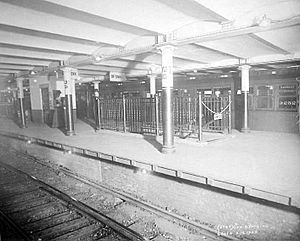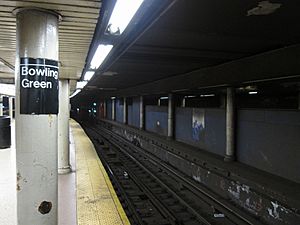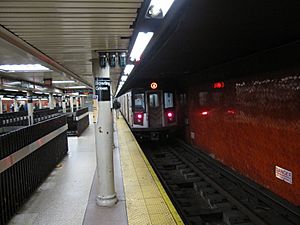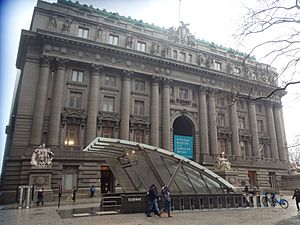Bowling Green station facts for kids
Quick facts for kids
Bowling Green
|
|||||||||||||
|---|---|---|---|---|---|---|---|---|---|---|---|---|---|

Platform for trains going to Brooklyn (right)
|
|||||||||||||
| Station statistics | |||||||||||||
| Address | Battery Place & Broadway New York, NY 10004 |
||||||||||||
| Borough | Manhattan | ||||||||||||
| Locale | Financial District | ||||||||||||
| Coordinates | 40°42′15″N 74°00′52″W / 40.70417°N 74.01444°W | ||||||||||||
| Division | A (IRT) | ||||||||||||
| Line | IRT Lexington Avenue Line | ||||||||||||
| Services | 4 alltimes (all times) 5 allexceptnights (all except late nights) |
||||||||||||
| Transit connections | |||||||||||||
| Structure | Underground | ||||||||||||
| Platforms | 1 side platform 2 island platforms (1 in use, 1 abandoned) |
||||||||||||
| Tracks | 2 | ||||||||||||
| Other information | |||||||||||||
| Opened | July 10, 1905 | ||||||||||||
| Station code | 414 | ||||||||||||
| Accessible | |||||||||||||
| Opposite-direction transfer available | Yes | ||||||||||||
| Traffic | |||||||||||||
| Passengers (2019) | 8,362,034 |
||||||||||||
| Rank | 39 out of 425 | ||||||||||||
| Station succession | |||||||||||||
| Next north | Wall Street: 4 alltimes 5 allexceptnights | ||||||||||||
| Next south | Borough Hall: 4 alltimes 5 weekdaysonly (Terminal): 5 weekendsonly South Ferry (loops; closed): no service |
||||||||||||
|
|||||||||||||
|
|||||||||||||
|
|||||||||||||
|
Battery Park Control House
|
|||||||||||||

Station headhouse on Battery Park dates to 1905
|
|||||||||||||
| Built | 1905 | ||||||||||||
| Architect | Heins & LaFarge | ||||||||||||
| MPS | Interborough Rapid Transit Subway Control Houses TR | ||||||||||||
| NRHP reference No. | 80002669 | ||||||||||||
| Significant dates | |||||||||||||
| Added to NRHP | May 6, 1980 | ||||||||||||
Bowling Green is a station on the IRT Lexington Avenue Line of the New York City Subway, located at Broadway and Battery Place (at Bowling Green), in the Financial District of Manhattan. It is served by the 4 train at all times and the 5 train at all times except late nights.
The station opened in 1905 as an extension of the Interborough Rapid Transit (IRT)'s original subway line to South Ferry. At the time, there was a single island platform with one exit at Battery Park and another in Bowling Green. When the Lexington Avenue Line was expanded to Brooklyn in 1908, some trains continued going to South Ferry, resulting in the creation of a short island platform at the Bowling Green station for the Bowling Green–South Ferry shuttle. The shuttle operated until 1977. During the 1970s, the station was completely renovated, a new exit was built, and a third, side platform was created for northbound trains.
The Bowling Green station contains three platforms: two island platforms and one side platform. The westernmost island platform, used by the shuttle, has not been in use since 1977. The station retains its original head house in Battery Park, which is listed on the National Register of Historic Places and a New York City designated landmark. There are two other exits to Bowling Green, one of which contains an elevator that makes the station compliant with the Americans with Disabilities Act of 1990.
Contents
History
Construction and opening
Planning for the city's first subway line dates to the Rapid Transit Act, authorized by the New York State Legislature in 1894. The subway plans were drawn up by a team of engineers led by William Barclay Parsons, chief engineer of the Rapid Transit Commission. The Rapid Transit Construction Company, organized by John B. McDonald and funded by August Belmont Jr., signed Contract 1 with the Rapid Transit Commission in February 1900, in which it would construct the subway and maintain a 50-year operating lease from the opening of the line. In 1901, the firm of Heins & LaFarge was hired to design the underground stations. Belmont incorporated the Interborough Rapid Transit Company (IRT) in April 1902 to operate the subway.
Several days after Contract 1 was signed, the Board of Rapid Transit Railroad Commissioners instructed Parsons to evaluate the feasibility of extending the subway south to South Ferry, and then to Brooklyn. On January 24, 1901, the Board adopted a route that would extend the subway from City Hall to the Long Island Rail Road (LIRR)'s Flatbush Avenue terminal station (now known as Atlantic Terminal) in Brooklyn, via the Joralemon Street Tunnel under the East River. Contract 2, giving a lease of 35 years, was executed between the commission and the Rapid Transit Construction Company on September 11, 1902. Construction began at State Street in Manhattan on November 8, 1902.
The Bowling Green station, constructed as part of Contract 2, opened on July 10, 1905. The station was originally built with a single island platform; a station head house at the south end, in Battery Park; and a secondary entrance at the northern end of the platform, adjacent to Bowling Green Park. There was as yet no Interborough Rapid Transit (IRT) service to Brooklyn, and all Lexington Avenue trains terminated at South Ferry's outer-loop platform.
Early modifications
The Joralemon Street Tunnel opened in 1908. Some trains continued to terminate at South Ferry, even during rush hours, while others went to Brooklyn. This service pattern was soon found to be inadequate for the high volume of Brooklyn riders. As a result, in 1908, the New York State Public Service Commission applied for authority to build a second, shorter platform and a third track to the west of the existing island platform. Three months after the Joralemon Street Tunnel opened, construction began on the third track and the western island platform at Bowling Green. Once they were completed in 1909, all rush-hour trains were sent to Brooklyn, with a two-car Bowling Green–South Ferry shuttle train providing service to South Ferry during those times. Even after the IRT Broadway–Seventh Avenue Line local service (1 train) began to South Ferry in 1918, the shuttle remained in operation until it was discontinued in 1977 due to budget cuts.
In 1909, to address overcrowding, the New York Public Service Commission proposed lengthening platforms at stations along the original IRT subway. On January 18, 1910, a modification was made to Contracts 1 and 2 to lengthen station platforms to accommodate ten-car express and six-car local trains. In addition to $1.5 million (equivalent to $47.1 million in 2022) spent on platform lengthening, $500,000 (equivalent to $15,703,571 in 2022) was spent on building additional entrances and exits. It was anticipated that these improvements would increase capacity by 25 percent. The main island platform at the Bowling Green station was extended 110 feet (34 m) to the north. On January 23, 1911, ten-car express trains began running on the East Side Line, and the next day, ten-car express trains began running on the West Side Line. In Fiscal Year 1937, the north end of the platform was extended 102 feet (31 m) to avoid the need to install gap fillers on the curve at the south end of the platform.
On September 8, 1952, the New York City Board of Transportation made the entrance kiosk at Battery Place and State Street entrance-only instead of exit-only in order to relieve congestion at the station during the evening rush hour. A fare box was installed at the top of the stairway to accommodate the change. In 1959, a new station house in Bowling Green Park was completed, with new stairways to the platform. In late 1959, contracts were awarded to extend the platforms at Bowling Green, Wall Street, Fulton Street, Canal Street, Spring Street, Bleecker Street, Astor Place, Grand Central, 86th Street and 125th Street to 525 feet (160 m) to accommodate ten-car trains.
Renovation
On March 5, 1972, the Metropolitan Transportation Authority (MTA) announced that the station would be renovated and expanded, doubling the capacity of the station, with work initially set to finished in 1974. The work was done in conjunction with the renovation of Bowling Green Park, which was rebuilt to conform with its appearance in the late 1700s.
As part of the project, a new northbound side platform was built to alleviate congestion on the narrow island platform, which would then only be used by downtown trains. In addition, stairs and a new mezzanine were built below track level, and a new exit with modern escalators was installed just south of Bowling Green, funneling some of the traffic away from the control house exit at the south end. The addition of this new entrance, and the expansion of the park, was made possible by closing the street named Bowling Green and turning it into a pedestrian plaza.
The new mezzanine was connected to the platform and street levels with ten new escalators. The capacity improvements were made by excavating using the cut-and-cover method in Bowling Green Park. The existing subway entrance at the west gate of the park was removed, providing more open space in the park. These capacity improvements were made to accommodate increased ridership resulting from the construction of additional office buildings in Lower Manhattan, including the World Trade Center. As part of the station renovation, it lost its historic mosaic tiles, which were replaced with bright red tiles, consistent with station renovation projects at 49th Street and the under-construction stations on the 63rd Street lines and Archer Avenue lines. In addition, the station's token booths were renovated.
On July 14, 1975, it was announced that the project's completion was then delayed to March 1976. The southern headhouse entrance was closed for six months beginning in April 1978 as it was being rehabilitated. The renovation was completed in 1978 at a cost of $16.8 million. Funding for the project was provided from the New York City Transit Authority (NYCTA)'s capital budget.
At midnight on February 13, 1977, service on the Bowling Green–South Ferry shuttle was discontinued, and the platform and the track used by the shuttle were abandoned. Service was discontinued as part of a three-phase cut in service that the NYCTA had begun in 1975 to reduce its operating deficits. Despite the discontinuation of the service, the shuttle platform was renovated as part of the station renovation project, receiving new tiling, signage, and refinished flooring. Some time after 1983, a fence was installed on the eastern edge of the island platform, which had been used to board trains prior to the opening of the side platform in 1978.
Subsequent improvements
In June 1999, MetroCard vending machines were installed in this station as part of the second batch of the fare-payment technology's installation. In early 2006, work began to make the station fully compliant with the Americans with Disabilities Act of 1990. As part of the project, the cobblestones around the station entrance near Bowling Green were replaced with granite pavers, an ADA-compliant path was constructed to Bowling Green Park, and a new glass canopy was installed over this entrance. The canopy, which was designed by Dattner Architects in 2003, consists of a curved steel and glass with stainless steel ribs, and is supported by a granite base. As part of the project, the unused shuttle platform was walled off between 2001 and 2002.
Work to install the canopy was scheduled to begin in late October 2006. In May 2007, the replacement of the cobblestones and installation of the glass canopy were completed. The elevators opened on July 9, 2007, but were formally opened the following day.
In 2020, the MTA tested a hearing induction loop for hard-of-hearing passengers on the northbound platform, the first such installation in the subway system.
Station layout
The station, located at Broadway and Battery Place, has two tracks and two platforms in service: a center island platform that serves southbound and terminating trains, and a side platform that serves northbound trains. A fence is located along the edge of the island platform, preventing northbound trains from releasing passengers onto the island platform. The side platform and the wall facing the downtown track have orange brick tiles. Both platforms have circular platform columns painted in beige.
An abandoned and walled-off island platform and track on the west side of the station were formerly used by the Bowling Green–South Ferry shuttle, which traveled to the inner platform at South Ferry. This platform was connected to the island platform with an underpass at its northern end.
Escalators and stairs connect both platforms to the mezzanine below track level, where free transfers can be made between the two platforms. On the uptown platform, pairs of escalators and staircases lead to the mezzanine, while on the downtown platform, alternating staircases and escalators descend to the mezzanine.
There are two banks of turnstiles on the north and south sides of the mezzanine, which is outside fare control. A pair of escalators and a staircase leads from the eastern end of the mezzanine to an upper mezzanine, which contains the token booth, and a bank of turnstiles, which leads directly onto the uptown side platform.
Two elevators make the station accessible under the Americans with Disabilities Act of 1990. One connects street level, the main northbound fare control, and the southbound fare control area below the platforms and tracks. The other connects the Brooklyn-bound platform with the fare control area below.
Track layout
South of the station, the tracks diverge into two sets. One set (the inner tracks) enter the Joralemon Street Tunnel to travel to Brooklyn. this route is used by the 4 train at all times and the 5 train on weekdays until 8:45 pm. The outer tracks continue to the closed South Ferry inner loop station, which is used by the 5 train when it short turns at this station during weekends and late weekday evenings.
Exits
The station has three street stairs, an elevator, a set of escalators, and an original control house (also known as a head house). These exits are clustered in three separate locations.
The eastern end of the upper mezzanine, toward the center of the station, leads to a pair of staircases and an up escalator that leads to Bowling Green plaza. There is a glass-canopied stairs-and-escalator entrance in front of the Alexander Hamilton U.S. Custom House, just around the corner from two entrances to the Whitehall Street–South Ferry station on the BMT Broadway Line (which are set into the building's eastern elevation).
At the eastern end of the lower mezzanine, a pair of escalators and a staircase lead to an intermediate level. This, in turn, leads to a pair of staircases on the north side of Battery Place between Greenwich Street and Broadway, outside the International Mercantile Marine Company Building.
A staircase, at the southern end of the island platform, leads to a fare control area in the restored control house. which consists of a pair of low turnstiles at the south end, and two high entry/exit turnstiles flanking the staircase down to the platform.
Control house
At the south end of the station is the original head house, known as the Bowling Green IRT Control House or Battery Park Control House, on the west side of State Street south of Broadway. This subway entrance was designed by Heins & LaFarge and built in 1905 on the west side of State Street, across from the Alexander Hamilton U.S. Custom House. It was built as one of several station houses on the original IRT; similar station houses were built at 72nd, 96th, 103rd, and 116th Streets. The control house is listed on the National Register of Historic Places and is a New York City designated landmark. Although most of the original subway's entry points had steel and glass kiosks (such as at Astor Place), important stations like Bowling Green were marked with a brick and stone control house, so called because they helped control the passenger flow.
The facade is made of yellow brick, with limestone banding and triglyphs at its tops, a base of granite, and a gable roof. The doorways to the control house are located on the north and south of the structure; the northern doorway has an elaborate pediment above it, and the southern doorway has been extended with three exit doors. Inside, the control house has turnstiles at street level and a single stair down to the extreme southern end of the island platform.
Artwork
The Bowling Green station has lightboxes with rotating content. Since 2018, the exhibition has been "Daily Voyage", featuring pictures taken by Glen DiCrocco of regular commuters on the Staten Island Ferry. Some of these photos can be seen on the MTA's Flickr account as well.
Nearby points of interest
There are numerous skyscrapers and other structures immediately surrounding the Bowling Green station (listed clockwise):
- Alexander Hamilton U.S. Custom House to the south; a New York City designated landmark on the National Register of Historic Places
- International Mercantile Marine Company Building, 1 Broadway; a New York City designated landmark on the National Register of Historic Places
- Bowling Green Offices Building, 11 Broadway; a New York City designated landmark
- Cunard Building, 25 Broadway; a New York City designated landmark
- 26 Broadway, the Standard Oil Company Building, on the east side of Broadway, facing the Cunard Building; a New York City designated landmark
- 2 Broadway, a Modernist glass wall that replaced the distinguished Produce Exchange Building (1881–1884, George B. Post), as an "acceptable sacrifice" intended to spur financial district rebuilding
Another park, the Battery, is located right outside the southern entrance. Charging Bull, a 7,100-pound (3,200 kg) bronze sculpture, is at the north end of Bowling Green Park, immediately north of the station.
- nycsubway.org – IRT East Side Line: Bowling Green
- nycsubway.org — The Essence of Time Artwork by Nicole Bengiveno (2007)
- nycsubway.org — A Way To Go Artwork by Zach DeSart (2009)
- Station Reporter — 4 Train
- Station Reporter — 5 Train
- Abandoned Stations — Bowling Green & South Ferry platforms
See also
 In Spanish: Bowling Green (línea de la Avenida Lexington) para niños
In Spanish: Bowling Green (línea de la Avenida Lexington) para niños












